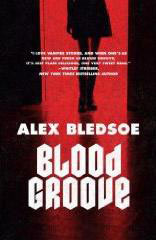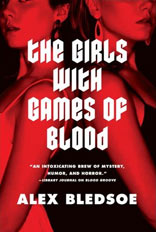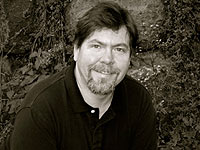Blood Writes: Q&A With Author Alex Bledsoe
Published on September 29th, 2010 in: Books, Halloween, Horror, Q&A |By Lisa Anderson
Alex Bledsoe is the author of the novels of the Memphis Vampires: 2009’s Blood Groove and The Girls with Games of Blood, which was released earlier this year (both from Tor books). For Popshifter‘s Halloween Horrors issue, he recently took time to answer some of my questions about writing and the bloodthirsty monsters currently enjoying such popularity.

Popshifter: What do you see as the future of the current vampire craze? Is it almost over, or will it keep going?
Alex Bledsoe: I think there will always be interest in vampires, because the subject is broad enough to encompass romance, satire, science fiction, teen angst, fantasy, and even straight horror. Any genre that includes Dracula, Edward Cullen and Lestat is rich enough to continue indefinitely. The craze may fade simply due to market saturation, but there will always be a readership for good, original vampire stories.
Popshifter: Who are your favorite vampires in literature, music, and television?
Alex Bledsoe: In literature, it all starts and ends with Dracula. Every subsequent vampire is either a reaction to, or a deliberate departure from, that template. I love the book; as literature, it’s brilliant on every level. After that I’d put J. Sheridan LeFanu’s novella “Carmilla.”
In movies, I’d have to say both versions of Nosferatu (1922 and 1979) are among my favorites. Also Frank Langella’s version of Dracula, which I like in spite of his non-period blow-dried hair. I enjoy all the Hammer films as well. My most recent pleasant surprise was the New Zealand film Perfect Creature.
On television, without a doubt it’s Janos Skorzeny, played by Barry Atwater in the TV movie The Night Stalker. He’s the only vampire who ever genuinely scared me. I’m also very fond of Louis Jourdan’s performance in the 1977 BBC adaptation, Count Dracula. That version, to me, is closest to the atmosphere of the book. I’ve watched some of the current shows, like True Blood, and I think they’re very entertaining, but only time will tell if they stick with you.
Popshifter: In The Girls with Games of Blood, we encounter vampires who were not made by other vampires. This is consistent with legends I’ve read, but I’ve never seen it used in fiction before. What went into this decision?
Alex Bledsoe: One concept I emphasized in Blood Groove was the disparity between what the “new” vampires believed about themselves based on movies and TV, and what Zginski (an Old World vampire) knew about being a vampire. I didn’t want to just rehash that in the sequel, but I still felt it was an important element. That’s the reason for having a different origin for the two vampire sisters, one in which their change to vampirism arose out of their own actions, without being “made” by another vampire.

Popshifter: Why did you start a horror series after having written published fantasy novels? What are the challenges and advantages of writing in two different genres?
Alex Bledsoe: I’d written both novels before The Sword-Edged Blonde was published. The fantasy novel just happened to be the one that sold first. So there was no conscious decision to change genres, except in the sense that in both cases I was writing about something that really interested me.
And the challenges of the two genres, and of any story really, are identical: take the story on its own level and tell it the best you can. With vampires, it’s important to decide what they represent: all monsters work best as metaphors. Once you’ve decided that, the rest is all about concentration.
Popshifter: Why did you choose the 1970s Memphis setting? What real people or events went into Blood Groove and The Girls with Games of Blood?
Alex Bledsoe: The setting arose out of the time frame. I wanted to set the story before the advent of Anne Rice and the self-pitying, self-aware vampire. Since Interview with the Vampire was published in 1976, I chose 1975. The city I knew best from that era is Memphis. The racism/sexism elements of the story grew organically out of the combination of time period and setting.
The geography of 1975 Memphis is as accurate as I can make it. The planetarium and museum in Blood Groove is based on the Pink Palace museum, and of course Sheriff Byron Cocker in The Girls with Games of Blood is inspired by, but not literally based on, Buford Pusser of Walking Tall fame.
Popshifter: Are you interested in writing about other classic monsters of the horror genre, such as zombies or werewolves?
Alex Bledsoe: I’d love to, if I can think of a good story. I have a great title for a zombie novel, but so far that’s all.
Popshifter: I have to say, the end of The Girls with Games of Blood really left me hanging! Are there going to be more novels in this series?
Alex Bledsoe: Depends on the sales, really. I’d love to do a third one to wrap up the loose ends, and I know what the story would be, but the publisher has to know there’s interest. As I said above, the vampire market is really saturated right now.
Popshifter: In the spirit of our Halloween issue, what were some of the things that scared you as a child (and maybe a little bit now)? Do they figure into your writing?

Alex Bledsoe: Bees. Bees and wasps. Total phobic terror. Anyone who knows me will tell you I shriek like a preteen girl if one comes around me. I haven’t yet been brave enough to incorporate it into my writing, though.
Originally from Tennessee, Alex now lives in Wisconsin with his wife and their two children. He has two books coming out next year: The Hum and the Shiver, a supernaturally themed novel set in East Tennessee, and Dark Jenny, the third book in his Eddie LaCrosse fantasy series. You can find more information about his work at his website or you can follow his blog.
Time limit is exhausted. Please reload the CAPTCHA.